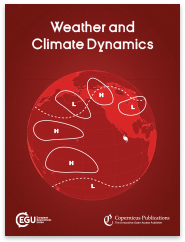
Executive editors: Camille Li, Stephan Pfahl & Heini Wernli
eISSN: WCD 2698-4016, WCDD 2698-4024
Weather and Climate Dynamics (WCD) is a not-for-profit international scientific journal dedicated to the publication and public discussion of high-quality research on dynamical processes in the atmosphere. It represents a timely effort to establish a seamless perspective on atmospheric flows, on scales from weather to climate (minutes to decades). The scope of the journal includes the following: the dynamics of extreme weather events (case studies and climatological analyses); weather system dynamics in tropical, midlatitude and polar regions; interactions of atmospheric flows with cloud physics and/or radiation; links between the atmospheric water cycle and weather systems; tropical-extratropical and midlatitude-polar interactions; atmospheric teleconnections and stratosphere-troposphere coupling; boundary-layer dynamics and coupling to land, ocean and ice; atmospheric variability and predictability on time scales from minutes to decades; storm track and Hadley cell dynamics; role of atmospheric dynamics in paleoclimate and climate change projections; and other aspects of weather and climate dynamics. Theoretical studies, idealized numerical studies, full-physics numerical studies, and diagnostic studies using (re)analysis and/or observational data are welcome.
Journal metrics
WCD is indexed in the Web of Science, Scopus, Google Scholar, etc. We refrain from displaying the journal metrics prominently on the landing page since citation metrics used in isolation do not describe importance, impact, or quality of a journal. However, these metrics can be found on the journal metrics page.
17 Jul 2025
Data-driven discovery of mechanisms underlying present and near-future precipitation changes and variability in Brazil
Márcia Talita A. Marques, Maria Luiza Kovalski, Gabriel M. P. Perez, Thomas C. M. Martin, Edson L. S. Y. Barbosa, Pedro Augusto S. M. Ribeiro, and Roilan H. Valdes
Weather Clim. Dynam., 6, 757–767, https://doi.org/10.5194/wcd-6-757-2025,https://doi.org/10.5194/wcd-6-757-2025, 2025
Short summary
Highlight articles
30 Sep 2024
The crucial representation of deep convection for the cyclogenesis of Medicane Ianos
Florian Pantillon, Silvio Davolio, Elenio Avolio, Carlos Calvo-Sancho, Diego Saul Carrió, Stavros Dafis, Emanuele Silvio Gentile, Juan Jesus Gonzalez-Aleman, Suzanne Gray, Mario Marcello Miglietta, Platon Patlakas, Ioannis Pytharoulis, Didier Ricard, Antonio Ricchi, Claudio Sanchez, and Emmanouil Flaounas
Weather Clim. Dynam., 5, 1187–1205, https://doi.org/10.5194/wcd-5-1187-2024,https://doi.org/10.5194/wcd-5-1187-2024, 2024
Short summary

More highlight articles  All EGU highlight articles
All EGU highlight articles 
News
10 Feb 2025
Thank you to all our referees in 2024!
A big thank you to all referees for their volunteer work in providing fair, thorough, and constructive peer-review reports! Through their invaluable contribution our interactive open-access journals maintain their high scientific standards and their ongoing success. 
10 Feb 2025
Thank you to all our referees in 2024!
A big thank you to all referees for their volunteer work in providing fair, thorough, and constructive peer-review reports! Through their invaluable contribution our interactive open-access journals maintain their high scientific standards and their ongoing success. 
05 Feb 2025
Copernicus Publications and all journals left Twitter
The Copernicus Twitter account as well as all Twitter accounts of journals published by us have been deactivated. There will be no automatic feeds of newly posted preprints or published journal articles anymore, we do not actively tweet, and the status informs that the accounts are no longer maintained. Twitter is no longer linked from the journal websites or in the share section of the preprint or journal article HTML pages.
05 Feb 2025
Copernicus Publications and all journals left Twitter
The Copernicus Twitter account as well as all Twitter accounts of journals published by us have been deactivated. There will be no automatic feeds of newly posted preprints or published journal articles anymore, we do not actively tweet, and the status informs that the accounts are no longer maintained. Twitter is no longer linked from the journal websites or in the share section of the preprint or journal article HTML pages.
Notice on the current situation in Ukraine
To show our support for Ukraine, all fees for papers from authors (first or corresponding authors) affiliated to Ukrainian institutions are automatically waived, regardless if these papers are co-authored by scientists affiliated to Russian and/or Belarusian institutions. The only exception will be if the corresponding author or first contact (contractual partner of Copernicus) are from a Russian and/or Belarusian institution, in that case the APCs are not waived.
In accordance with current European restrictions, Copernicus Publications does not step into business relations with and issue APC-invoices (articles processing charges) to Russian and Belarusian institutions. The peer-review process and scientific exchange of our journals including preprint posting is not affected. However, these restrictions require that the first contact (contractual partner of Copernicus) has an affiliation and invoice address outside Russia or Belarus.



